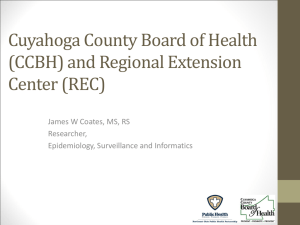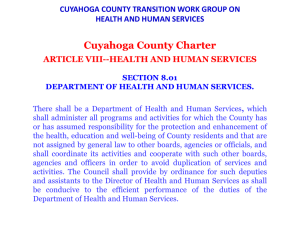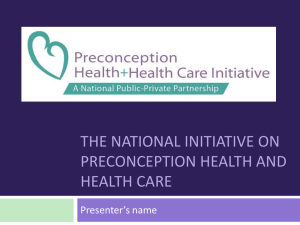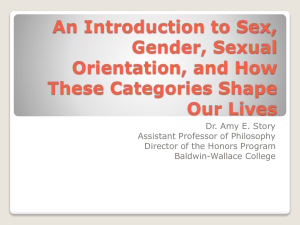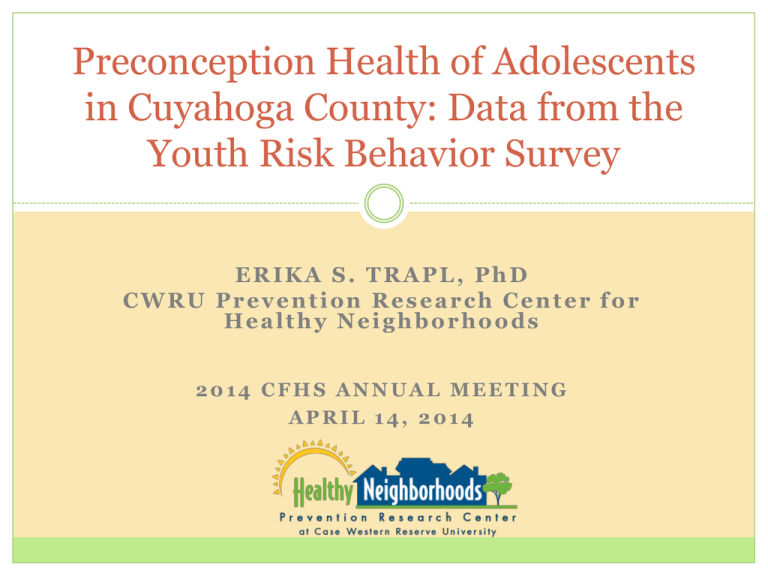
Preconception Health of Adolescents
in Cuyahoga County: Data from the
Youth Risk Behavior Survey
ERIKA S. TRAPL, PhD
CWRU Prevention Research Center for
Healthy Neighborhoods
2014 CFHS ANNUAL MEETING
APRIL 14, 2014
Acknowledgements
Funding provided by:
Ohio Department of Health/Federal Government, Bureau of
Child and Family Health Services through the Cuyahoga
County Board of Health’s Child and Family Health Service
Program
Centers for Disease Control and Prevention (1-U48-DP001930)
St. Luke’s Foundation
The PRCHN at CWRU
Mission: To work with communities from within to
prevent and reduce chronic disease
Received CDC funding to establish PRC in 2009…
BUT, we’re actually much older than that:
Center for Health Promotion Research: ~2000
Center for Adolescent Health: ~1995
Today’s Presentation
Brief history and overview of YRBS
Preconception Health in Cuyahoga County
Discussion
PRCHN and the YRBS
Conducting local YRBS (in some way) since 1998
Reports publicly available since 2002
Established current approach in 2008
Countywide administration in Cuyahoga County
Middle School in Spring of even years (e.g. 2012)
High School in Spring of odd years (e.g. 2013)
Attempt “region” representation
Cuyahoga County Regions
Youth Risk Behavior Survey
Developed by the Centers for Disease Control and
Prevention
Started in 1991
Administered to 9th-12th grade students every other year
Provides a “snapshot” of students’ health risk
behaviors
Used to follow trends over time
Measure progress against health indicators
Youth Risk Behavior Survey
Wide array of topics:
Originally designed to assess 6 types of health risk behaviors
Unintentional injuries and violence, sexual behaviors, alcohol and
other drug use, tobacco use, unhealthy dietary behaviors,
inadequate physical activity
Nationally expanded to include obesity and asthma
CDC provides standardized ‘optional’ items for consideration
Food Security, Preventive Health Care, Protective Factors
Why a Local YRBS?
LOCAL DATA is the richest data.
National YRBS is collected at the state-level
Ohio Department of Health leads this
State level data not sufficient for counties
Rarely can sufficient sample be drawn to weight to each county
Ex: 7 high schools in Cuyahoga selected for Ohio YRBS
ODH is great, but has limited resources
Can offer technical assistance but cannot feasibly conduct locally
Why a Local YRBS?
Flexibility
Sample selection
Survey design and content
Use of results
Can be used for more efficient resource planning,
grant writing, and program evaluation
Surveillance is a natural tool for assessment, intervention
identification, and evaluation.
Responsive to community needs
Policy for Sharing
Who owns the data?
CWRU is steward of the data in CC; CCBH also holds data
Who can access it?
CWRU has data sharing agreement developed with sensitivity
to funders’ needs (e.g. funding acknowledgement and
publication rules)
Ensures that those using the data use it appropriately
Policy for Sharing Data
Two potential issues:
Access to de-identified county-level file
Probably not a big deal
Access to identifiable school-level data
Probably a BIG deal
School confidentiality has been key in Cuyahoga
Use of school-level reports by media
Process for school permission to release school-specific data
Schools must be a partner
YRBS & Preconception Health
Lifecourse Perspective: Preconception health
considerations should begin at adolescence (i.e.
puberty)
Lifestyle risk factors for poor birth outcomes often
begin during adolescence
YRBS provides a natural mechanism by which to
monitor preconception health of adolescent females
Granular data at local level could inform targeted
program and policy approaches to improve
preconception health
Presentation of the Data: Key
US-F: National data, female participants
OH-F: Ohio data, female participants
CC-All: Cuyahoga County data, all participants
CC-F: Cuyahoga County data, female participants
City-F: Cleveland data, female participants
IR-F: Inner-ring suburbs data, female participants
OR-F: Outer-ring suburbs data, female participants
Sexual Behavior: 2013 High School YRBS
70.0%
64.9%
59.3%
60.0%
50.0%
40.0%
32.0% 30.9%
30.0%
CC-F
20.0%
10.0%
CC-All
14.8%
10.6%
7.1%
3.2%
3.9% 3.9%
0.0%
Sex <13
4+
Current Condom Pregnant
Partners
Sex
Use
Sexual Behavior: 2013 High School YRBS
70.0%
59.3%
60.0%
54.6%
50.0%
43.3%
40.0%
34.2%
CC-F
30.9%
30.0%
US-F
OH-F
20.0%
10.0%
35.2%
12.6%
10.6%
3.2% 3.4%
4.3%
15.8%
3.9%
0.0%
Sex <13
4+
Current Condom Pregnant
Partners
Sex
Use
Sexual Behavior: 2013 High School YRBS
70.0%
64.4%
59.3% 59.1%
60.0%
55.0%
50.0%
40.0%
33.6%
27.0%
20.0%
0.0%
City-F
30.9%
30.0%
10.0%
CC-F
34.3%
IR-F
OR-F
13.7% 13.8%
10.6%
5.9%
3.5%
3.2%
1.7%
Sex <13
8.3%
6.7%
3.9%
5.0%
1.1%
4+
Partners
Current
Sex
Condom
Use
Pregnant
Substance Use: 2013 High School YRBS
40.0%
37.3% 37.0%
34.9%
35.0%
30.0%
27.0%
25.0%
23.8%
23.5%
CC-F
20.5%
20.0%
City-F
18.8%
16.5%
15.0%
10.0%
IR-F
14.7%
8.8%
11.9%
10.1%
9.0%
6.3%
10.7%
8.7% 8.8%
6.5%
7.0%
5.0%
0.0%
Cigarettes
Cigars
Alcohol
Marijuana RX Drugs
OR-F
Obesity: 2013 High School YRBS
70.0%
59.4%
60.0%
60.6% 60.1%
55.6%
50.0%
41.1%
40.0%
CC-F
31.6%
30.0%
25.7%
22.7%
18.4%
20.0%
10.0%
10.9%
14.5%
14.8%
City-F
IR-F
OR-F
17.1%
13.9%
9.3%
4.6%
0.0%
Obese
Ovewt
Ovwt+Obese
Trying to
Lose
Physical Activity: 2013 High School YRBS
60.0%
50.0%
40.0%
39.4%
49.4%
49.0%
47.1%
38.3%
35.6%
30.8%
30.2%
30.0%
36.8%
38.2%
CC-F
30.1%
24.1%
20.0%
18.6%
20.4%
IR-F
19.0%
OR-F
12.1%
10.0%
0.0%
Met PA
No PA
City-F
3+hr TV
3+hr VG
Nutrition & Sleep: 2013 High School YRBS
45.0%
42.3%
40.0%
40.0%
35.0%
33.3%
31.2%
30.0%
25.0%
20.0%
30.3%
28.7%
25.2%
20.8%
17.9%
17.1%
15.0%
33.2%
CC-F
24.2%
City-F
19.7%
17.3%
IR-F
17.2%
OR-F
12.2%
10.0%
5.0%
0.0%
5 F/V
Pop daily
Daily brkfst
Adeq Sleep
Responsible Sexual Behavior – High School
90%
85%
80%
75%
70%
65%
60%
55%
50%
45%
40%
35%
84.5%
88.2%
68.0%
67.9%
63.2%
62.1%
50.1%
88.1%
62.2%
59.8%
58.4%
47.1%
42.4%
2007
65.1%
2009
Ever Sexual Intercourse
Condom Use
2011
39.3%
2013
Current Sexual Intercourse
HIV/AIDS Education
Summary
Offers an effective means to monitor preconception
health risk factors over time
Provides insight on targeting strategies or dispersing
resources geographically
Surveillance is a natural evaluation of programmatic
efforts
Questions?
Prevention Research Center for Healthy Neighborhoods
Erika S. Trapl, PhD
Assistant Professor, Dept. of Epidemiology & Biostatistics
Associate Director, Prevention Research Center for Healthy Neighborhoods
Case Western Reserve University
Phone: 216-368-0098
Erika.Trapl@case.edu
Jean L. Frank, MPH
Manager of Community Initiatives
Phone: 216-368-5913
Jean.Frank@case.edu
www.prchn.org/yrbs.aspx

